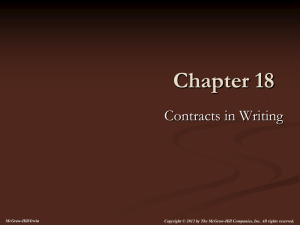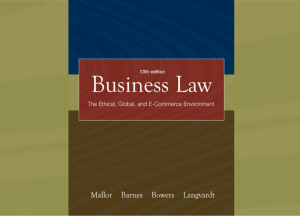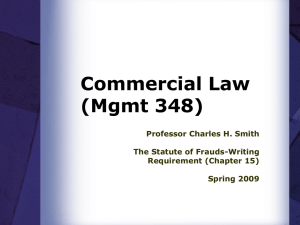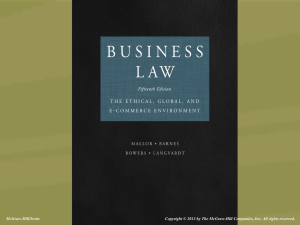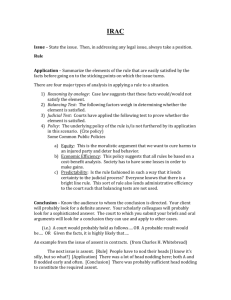OUTLINE OF THE STATUTE OF FRAUDS, THE PAROL EVIDENCE RULE, AND RULES OF CONTRACTUAL INTERPRETATION
advertisement
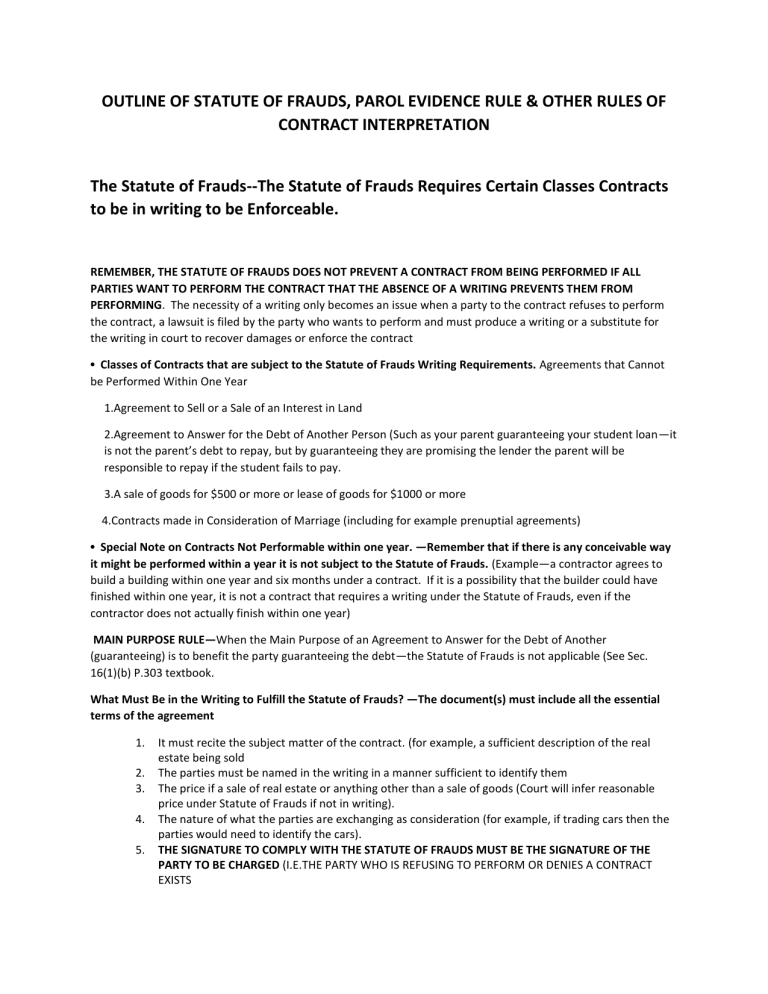
OUTLINE OF STATUTE OF FRAUDS, PAROL EVIDENCE RULE & OTHER RULES OF CONTRACT INTERPRETATION The Statute of Frauds--The Statute of Frauds Requires Certain Classes Contracts to be in writing to be Enforceable. REMEMBER, THE STATUTE OF FRAUDS DOES NOT PREVENT A CONTRACT FROM BEING PERFORMED IF ALL PARTIES WANT TO PERFORM THE CONTRACT THAT THE ABSENCE OF A WRITING PREVENTS THEM FROM PERFORMING. The necessity of a writing only becomes an issue when a party to the contract refuses to perform the contract, a lawsuit is filed by the party who wants to perform and must produce a writing or a substitute for the writing in court to recover damages or enforce the contract • Classes of Contracts that are subject to the Statute of Frauds Writing Requirements. Agreements that Cannot be Performed Within One Year 1.Agreement to Sell or a Sale of an Interest in Land 2.Agreement to Answer for the Debt of Another Person (Such as your parent guaranteeing your student loan—it is not the parent’s debt to repay, but by guaranteeing they are promising the lender the parent will be responsible to repay if the student fails to pay. 3.A sale of goods for $500 or more or lease of goods for $1000 or more 4.Contracts made in Consideration of Marriage (including for example prenuptial agreements) • Special Note on Contracts Not Performable within one year. —Remember that if there is any conceivable way it might be performed within a year it is not subject to the Statute of Frauds. (Example—a contractor agrees to build a building within one year and six months under a contract. If it is a possibility that the builder could have finished within one year, it is not a contract that requires a writing under the Statute of Frauds, even if the contractor does not actually finish within one year) MAIN PURPOSE RULE—When the Main Purpose of an Agreement to Answer for the Debt of Another (guaranteeing) is to benefit the party guaranteeing the debt—the Statute of Frauds is not applicable (See Sec. 16(1)(b) P.303 textbook. What Must Be in the Writing to Fulfill the Statute of Frauds? —The document(s) must include all the essential terms of the agreement 1. 2. 3. 4. 5. It must recite the subject matter of the contract. (for example, a sufficient description of the real estate being sold The parties must be named in the writing in a manner sufficient to identify them The price if a sale of real estate or anything other than a sale of goods (Court will infer reasonable price under Statute of Frauds if not in writing). The nature of what the parties are exchanging as consideration (for example, if trading cars then the parties would need to identify the cars). THE SIGNATURE TO COMPLY WITH THE STATUTE OF FRAUDS MUST BE THE SIGNATURE OF THE PARTY TO BE CHARGED (I.E.THE PARTY WHO IS REFUSING TO PERFORM OR DENIES A CONTRACT EXISTS • Note the Statute of Frauds can be Fulfilled by Integration of Several Documents That When Read Together Show All the Terms of the Contract. Note words INCORPORATION BY REFERENCE (Section 16-3a P. 311 Textbook) (Example—Two parties exchange a series of letters that clearly show a contract to sell land was made. The necessary terms of the contract can be scattered among the several letters so long as they show when taken altogether that there was a contract and what the terms of it were, and the signature of the party to be charged (i.e. the party refusing to perform—signed one of the letters reflecting his/her agreement). Incorporation by reference-- Lawyers in particular frequently use the term in a document that provides that another document is “incorporated by reference. If the additional terms are in the document that are incorporated, it makes a particularly strong case for concluding the other document can be referenced to fulfill the Statute of Frauds. Does not Have to Be a formal Written Contract--Remember that the Statute of Frauds writing requirement does not require a formal contract, but the writing requirement can also be fulfilled by a Note or Memorandum or even the terms written down on a napkin. See example at 16-1 in the textbook. • (Example—Two parties exchange a series of letters that clearly show a contract to sell land was made. The necessary terms of the contract can be scattered among the several letters so long as they show when taken altogether that there was a contract and what the terms of it were, and the signature of the party to be charged (i.e. the party refusing to perform—signed one of the letters reflecting his/her agreement). Incorporation by Reference—Lawyers in particular frequently use the term in a document that provides that another document is “incorporated by reference. If the additional terms are in the document that are incorporated, it makes a particularly strong case for concluding the other document can be referenced to fulfill the Statute of Frauds. • EXCEPTIONS TO THE STATUTE OF FRAUDS THAT WILL ALLOW ENFORCEMENT OF A CONTRACT EVEN IF IT IS NOT IN WRITING. 1. Partial Performance Accepted-- a buyer has taken partial possession of real or personal property and paid that part of the contract price attributable to the property received, or if the buyer has been allowed to move on the property under a verbal sales contract and starts to make improvements, such as building a building. 2.Promissory Estoppel-- If a promisor makes a promise on which the promisee justifiably relies to the promisee’s detriment, the promisor may be estopped from denying the existence and validity of the contract. 3. Recovery for reasonable value of services This is a quasi-contract remedy (not enforcing terms of the contract, but court makes other party pay reasonable value to prevent unjust enrichment. The Parol Evidence Rule--The rule prevents parties who have reduced their agreement to a final written document from later introducing other evidence, such as the content of oral discussions from earlier negotiation process or other writings that would provide additional terms or conflicting terms to the final written document. • The Parol Evidence Rule protects the parties who have reduced their agreement to a final writing. One party cannot come in and argue—no there are additional terms or different terms we agreed than appear in the final written contract. (Example: Final Written Contract exists between an attorney and a new attorney to the firm that he/she will be paid $250,000 for the year, but nowhere does the writing indicate that the attorney is to be paid additional amounts as a bonus if he/she bills over 2500 hours for the year. The attorney cannot prevail in a lawsuit where he/she claims there was an agreement for a bonus because it is not included as a term in the final written contract). • Requirement that the Written Contract Be a Final Agreement for the Parol Evidence Rule to Apply— The written agreement must clearly show that it was the final agreement of the parties for the Parol Evidence Rule to Apply Merger Clause—Many written contracts include a merger clause near the end of the written agreement that provides language such as “This agreement is the final statement of the parties’ contract. There are no other agreements, written, oral, or otherwise. All terms of the parties’ agreement are contained in this writing.” The merger clause is not necessary to demonstrate it is the final written agreement, but serves the purpose of preventing disputes over whether the written agreement is the final document ••Exceptions to Parol Evidence Rule—See Section 16-2b P. 309 of Textbook (Situations where evidence outside the final written contract can be introduced into evidence despite the Parol Evidence Rule). Exceptions listed below: 1.Errors or defects that would make the written contract void or voidable (due to mistake, fraud, duress, undue influence, illegality, etc.) (See example at 16-2b of the text) 2 Ambiguity in the Written Agreement—Ambiguity means the contract is unclear and there are conflicting terms within the written contract that could reasonably be interpreted in two or more ways. (Example—the contract at one point provides that the sales price for the property being sold is $225,000 and at another point indicates the sales price is $225,000) 3.Subsequent modifications of the Written Agreement or Termination—The parties to a final written agreement after it has been signed may later in time agree to modify the terms of the written contract or agree to terminate the agreement. The Parol evidence rule allows verbal testimony or written documents to reflect this has occurred. RULES OF CONSTRUCTION AND INTERPRETATION OF CONTRACTS Frequently Written Contracts are unclear and ambiguous (know the meaning of ambiguity) in their terms and courts must interpret the true terms of the agreement so that courts are called upon in lawsuits to enforce the written agreement, for recovery of damages, or in lawsuits brought requesting a declaration of what the contract means. The Courts apply the following Rules of Constructing and Interpreting the Written Contract when the written agreement is not clear. 1. 2. 3. 4. Interpret to Find the True Intention of the Parties-- Courts always interpret contract terms with the goal of identifying the intention of the parties. Determining the intent of the parties should be an objective analysis. Specific Terms Prevail Over General Terms in the Contract--If a court tries to allow both conflicting terms by harmonizing them, the court will have specific terms qualify general terms. The Contract is Interpreted to Give Meaning to All the Terms- A court must attempt to give effect to all the provisions in a contract. A court must consider the contract as a whole. Plain Meaning is Given Words-- The plain meaning of the contract will be followed where the words used—whether written or oral—have a clear and unambiguous meaning 5. Technical terms are given their technical meaning—All trades and professions have special terms such as “Code Red” in the Practice of Medicine; or “Net Present Value” in appraising the value of property, or “triple net lease” in leasing commercial property. When terms of art in an industry are included—they are given the meaning they have in that industry. 6. Printed Forms, Typed in Terms, and Hand Written Terms—When the contracting parties use a preprinted form, any terms the parties hand write in have priority in the interpretation, specially typed in words have second priority, and the terms of the preprinted form take lowest priority. 7. Ambiguities are Construed Against the Drafting Party—If the terms are unclear such as the example of the contract at one point saying sale price of $250,000 and later in the agreement $225,000, whichever interpretation benefits the party that did not draft the contract (i.e. write up the contract) prevails. The ambiguity is interpreted against the party that wrote the contract. The parties in the agreement can nullify this rule by agreeing the contract will not be interpreted against either party to the contract.

